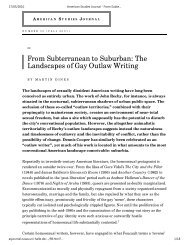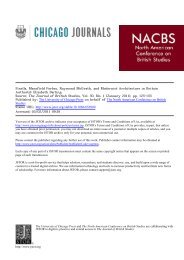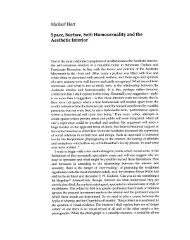sacrilege in the sitting room: contesting suburban ... - Fritz Haeg
sacrilege in the sitting room: contesting suburban ... - Fritz Haeg
sacrilege in the sitting room: contesting suburban ... - Fritz Haeg
Create successful ePaper yourself
Turn your PDF publications into a flip-book with our unique Google optimized e-Paper software.
HOME CULTURES<br />
178<br />
MARTIN DINES<br />
o<strong>the</strong>r than “talk of sports and makes of cars/ In various bogus Tudor<br />
bars” (<strong>in</strong> Skelton 1964: 75). C. Day Lewis decries <strong>the</strong> pelmet-high<br />
horizons of <strong>the</strong> ubiquitous villa-dweller, tak<strong>in</strong>g <strong>the</strong> new availability of<br />
luxuries—<strong>in</strong> particular mass-produced labor-sav<strong>in</strong>g devices and soft<br />
furnish<strong>in</strong>gs—as demonstrative of <strong>suburban</strong>ites’ fem<strong>in</strong><strong>in</strong>e <strong>in</strong>dolence<br />
and depoliticized self-satisfaction: <strong>the</strong>y are “at bay <strong>in</strong> villas [. . .]<br />
content with cushions” (Day Lewis 1992: 161). I will return later to<br />
<strong>the</strong> long-established association between embourgeoisized fem<strong>in</strong><strong>in</strong>ity<br />
and <strong>the</strong> <strong>suburban</strong> domestic <strong>in</strong>terior as it strongly permeates certa<strong>in</strong><br />
recent gay texts.<br />
For most <strong>in</strong>tellectuals <strong>in</strong> <strong>the</strong> early to mid-twentieth century, like<br />
<strong>the</strong> term “<strong>the</strong> masses,” “<strong>the</strong> word ‘<strong>suburban</strong>’ [was] a sign for <strong>the</strong><br />
unknowable” (Carey 1992: 53). Contributors to <strong>the</strong> <strong>suburban</strong> critical<br />
canon were typically distanced and isolated from <strong>the</strong> culture <strong>the</strong>y<br />
mistrusted and feared. By contrast, more recent <strong>suburban</strong> narratives<br />
are much more likely to be steeped <strong>in</strong> <strong>the</strong> experience of suburbs.<br />
Miranda Sawyer’s recent exploration of Brita<strong>in</strong>’s suburbs, Park and<br />
Ride, for <strong>in</strong>stance, is avowedly <strong>in</strong>spired by <strong>the</strong> author’s <strong>suburban</strong> provenance<br />
(Sawyer 1999). Accord<strong>in</strong>g to Mark Clapson, much <strong>the</strong> same<br />
can be said for historians of <strong>suburban</strong>ization: an <strong>in</strong>creas<strong>in</strong>g number<br />
preface <strong>the</strong>ir work with a declaration of <strong>the</strong>ir <strong>suburban</strong> background,<br />
which apparently correlates with noticeably less condemnatory<br />
assessments of suburbia (Clapson 2003: 9). It is of course certa<strong>in</strong>ly<br />
<strong>the</strong> case <strong>the</strong> <strong>suburban</strong> orig<strong>in</strong>s of some cultural producers <strong>in</strong>spire<br />
little else than vitriol: for example, almost <strong>the</strong> whole of Mike Leigh’s<br />
c<strong>in</strong>ematic oeuvre, from Abigail’s Party (BBC, 1977) to Vera Drake<br />
(UK, 2004), constitutes a susta<strong>in</strong>ed and wi<strong>the</strong>r<strong>in</strong>g attack on <strong>the</strong><br />
aspirant pretensions of suburbia and, <strong>in</strong> particular, <strong>suburban</strong> women. 2<br />
Never<strong>the</strong>less, numerous recent <strong>suburban</strong> narratives accord with<br />
Paul H. Matt<strong>in</strong>gly’s desire to wrest <strong>the</strong> cultural evaluation of suburbs<br />
away from <strong>the</strong> <strong>suburban</strong> critical canon and for it to be taken <strong>in</strong>to <strong>the</strong><br />
hands of those who have <strong>in</strong>vested <strong>the</strong>ir lives <strong>the</strong>re. Instead of a place<br />
that is always alien or merely escaped from, both Matt<strong>in</strong>gly (1997:<br />
41–2) and Peter Lang wish to see more analysis of <strong>the</strong> attractions<br />
of suburbs, <strong>the</strong>ir “tremendous gut appeal” (Lang 1997: 7).<br />
Gay narratives, particularly, frequently locate <strong>in</strong> suburbia sources<br />
of excitement and opportunity, usually sexual. By identify<strong>in</strong>g sites<br />
of sexual <strong>in</strong>terest <strong>in</strong> <strong>the</strong> suburbs, however, gay stories are not mere<br />
variants of <strong>the</strong> conventional “dual-narrative” of suburbia, where<br />
respectable conformity—neat lawns and washed-every-Sunday cars,<br />
n<strong>in</strong>e-to-five regularity, etc.—conceals (hetero)sexual licentiousness<br />
go<strong>in</strong>g on <strong>in</strong>doors. Arguably one of <strong>the</strong> most graphic and critical<br />
render<strong>in</strong>gs of this k<strong>in</strong>d of sexual duplicity was <strong>the</strong> early punks’ choice<br />
of fetish outfits and paraphernalia for everyday wear. Such a style was,<br />
accord<strong>in</strong>g Barry Langford, “<strong>in</strong>tended as both deeply <strong>suburban</strong> and a<br />
clear rebuke to a <strong>suburban</strong> sexuality <strong>the</strong>y excoriated as hypocritical,<br />
dissimulat<strong>in</strong>g and coercive” (Langford 2000: 70). 3 But if gay narratives








